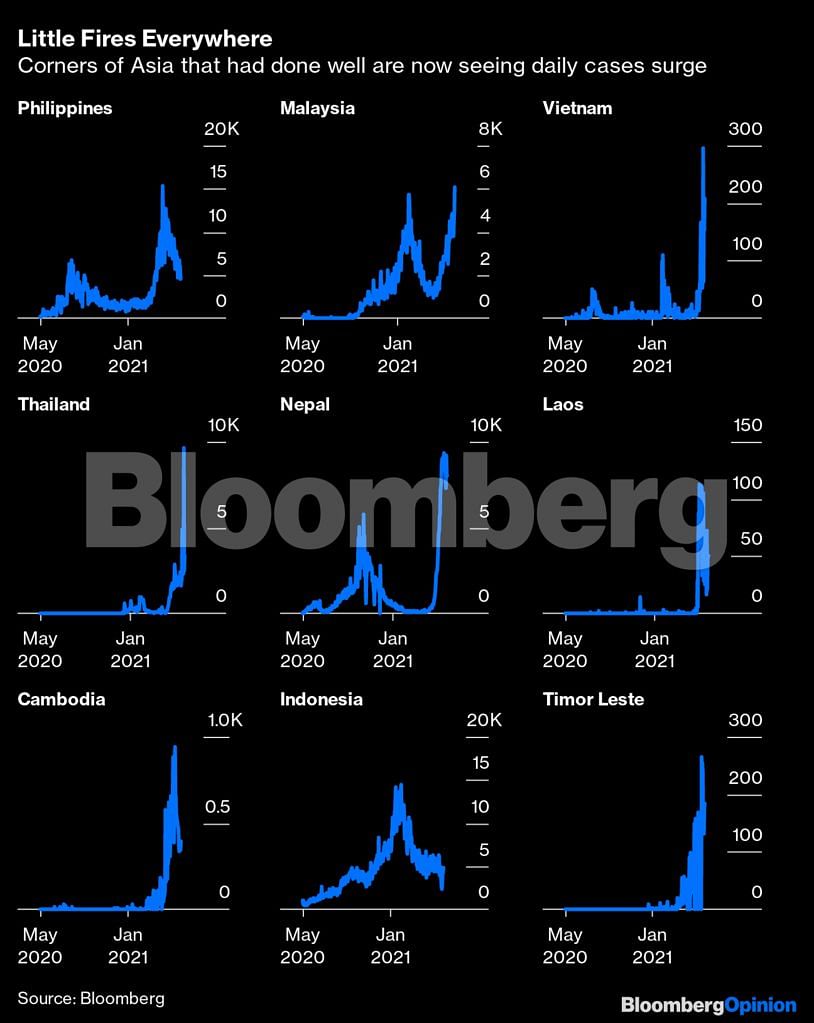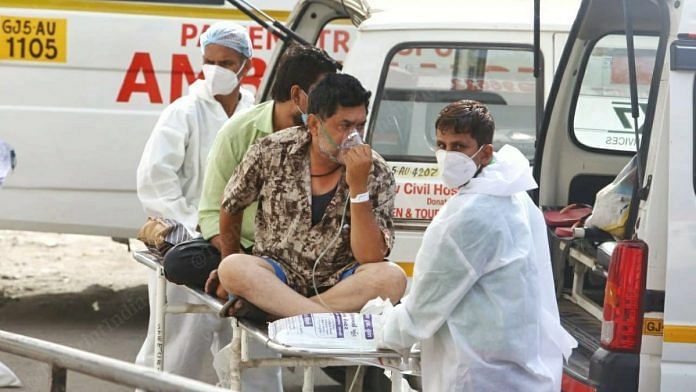Complacency, populism and poor infrastructure fueled a devastating second wave of Covid-19 in India, a disaster that has infected millions and wrought havoc well beyond its borders thanks to a new, more contagious variant. But none of those failings are unique to the country. So why are we not paying more attention to surges elsewhere in the neighborhood, in places no better equipped to contain a spike or track new mutations?
Alarm bells should be ringing across Southeast Asia. It’s bad enough in Thailand, Malaysia and even, to a more modest degree, Vietnam, all hitting record daily cases far worse than in earlier waves. Indonesia is edging toward 6,000 new daily infections, and the Philippines on Saturday announced over 6,800. It’s too early to know if that’s just a blip in a recent downward trend, or something more serious.
But a bigger concern should be the region’s poorer corners that, until now, had escaped the worst. Cambodia saw a surge so severe last month that leader Hun Sen said his country was “on the brink of death.” New infections have eased, but overall case numbers are now well over 24,000, from a 10th of that in early April. Laos had a total of less than 50 cases at the start of April, but official figures are now at more than 1,700. In Myanmar, it’s hard to even know the extent of the spread, given testing virtually dried up after a military coup in February.
It’s all coming at a time when economies and households are weakened by the consequences of more than a year of virus restrictions, and few governments are eager to repeat 2020 lockdowns. Vaccine rollouts are slow and borders porous, with cases already turning up in China. Laos has roughly 5,000 kilometers, some 3,100 miles, of frontiers with five neighbors, and early cases in this wave involved people crossing the Mekong River from Thailand.
Then there are wealthier countries, like Singapore and Taiwan, that had been seen as havens for their success in controlling the virus and are now grappling with outbreaks and imposing tighter restrictions. Japan is an unmitigated Covid-19 mess, with a fresh wave of cases, one of the lowest vaccination rates among affluent nations, and a looming Olympic Games opposed by more than 80% of the population.

Asia isn’t alone. South American authorities are struggling with new waves and a worrying variant, this time coming out of Brazil, where a president who scoffs at the disease has left hospitals struggling. But it’s a striking example — and not the first in this pandemic — of how we keep repeating the same mistakes.
Two clear lessons need to be taken on board. The first, simply, is that there’s no way of controlling the coronavirus without vaccines. It’s the reason parts of Europe and the United States are now seeing lower numbers and discussing summer holiday plans. Thailand, by contrast, wants to reopen the tourist island of Phuket but has fully vaccinated just over 1% of its population and is seeing prison outbreaks so severe it’s contemplating pardons.
A low vaccination rate left Taiwan exposed when cases broke through its defenses, and it’s a similar story in Singapore, where more citizens are immunized — just not enough of them. Both are now scrambling. The Lion City, forced to cancel high-profile events like the World Economic Forum, is rushing to give all adults a first shot by the end of August and will lengthen time between doses to cover more people.
That should be a warning to places where local cases are currently under control but vaccination rates remain anemic. Less than 12% of Hong Kong’s population has had both doses. Australia has moved at such a leisurely pace — “a marathon and not a sprint” — that enough doses have been given to cover just 7% of the population. Both should be doing far more to prepare.
And there’s a second, vital lesson from India, and indeed Brazil. That’s the cost to the wider world of allowing hotspots to develop unmonitored, with insufficient testing, tracking and genome-sequencing abilities, which allow health authorities to keep up with the evolution of the virus and act accordingly. Their absence leaves everyone flying blind.
Consider Myanmar, already one of the worst-hit and least-prepared countries in Southeast Asia, with threadbare hospitals and just 0.7 intensive care beds and 0.5 ventilators per 100,000 people. India, by comparison, had a little over two beds, and South Korea nearly 11. None of that was helped by the military takeover, and doctors and nurses have been at the forefront of civil disobedience. Testing has fallen to a daily average of fewer than 1,000 samples from a paltry 18,000 before the coup. There is little hope for mass vaccination.
Variants must be caught before they explode, and we can’t afford to overlook what’s happening now across the region. The double mutant variant seen in India was around in December, but progressed unchecked. More are bound to emerge at this phase of the pandemic. That means urgent outside support and attention.
It isn’t, yet, all over. –Bloomberg
Also read: Concern rises as Covid variant from India spreads in UK, exposing Britain’s weakness



